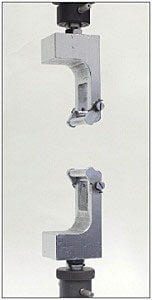1 kN Henry Scott Grips

Features:
- Maximum capacity of 1 kN (220 lbf)
- Includes a self-clamping action
- Enables quick sample mounting
- Applicable for testing rubber, soft plastics, paper, and cloth
Relevant Materials:
Rubber, Soft Plastics, Paper, Cloth
Relevant Specimens:
Plates, Tapes
Henry Scott grips are useful for clamping plate and tape specimens of soft, flexible materials for tensile testing. Specimens are held by rollers on the upper and lower grips, which feature a self-clamping action. To minimize specimen slippage, the grip body opposite the roller, where the specimen contacts, is curved and features a parallel-grooved surface. During tensile testing, the self-clamping action applies increasing clamping force to the specimen as the overall force increases to help hold the specimen in place.
News / Events
-
AUTOGRAGH AGS-X2 Series has been released
The Shimadzu AUTOGRAPH AGS-X2 series provides superior performance and practical testing solutions for a wide array of applications. Offering high-level control and intuitive operation, the AGS-X2 series sets a new standard for strength evaluations while providing the utmost in safety considerations in a modern, stylish design.
-
AUTOGRAGH AGS-V Series has been released
Shimadzu Corporation released the Autograph AGS-V Series precision universal testing machine. In this series, the range over which the force measurement accuracy is guaranteed has been increased by a factor of two compared with existing machines. As a result of this new function, the work required to change force measurement sensors and accessories required for measurement can be reduced.
-
High-Speed Video Camera HyperVision HPV-X3 has been released
Recording speed of 20 million frames/second, the highest in its class provides larger, clearer, high-sensitivity recording. HPV-X3 is equipped with a synchronized recording function and high-level analytical capabilities that accommodate a variety of software programs.
-
New Video: AUTOGRAPH AGX-V2 Voice Operation Device XV-Talk
We will introduce how XV-Talk, the world's first voice control device installed in Shimadzu's latest tensile tester AGX-V2, can be used in various scenarios.
-
New Video: AUTOGRAPH AGX-V2 Operation Control Panel Stand-alone test feature
We will introduce a new feature of Shimadzu's latest tensile tester, AGX-V2, a stand-alone testing function using a large color LCD touch panel.
-
New Autograph AGX-V2 Series Precision Universal Testing Machines
The World’s First Testing Machines Equipped with a Voice Operation Device


